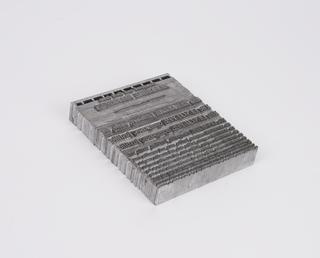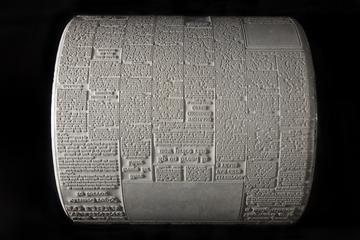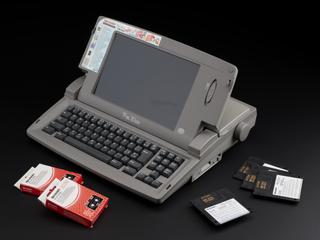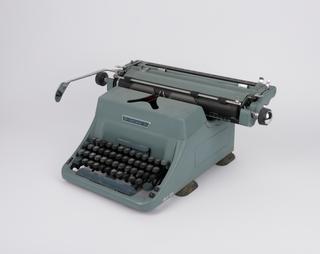
Monotype Standard Model D Keyboard




Monotype Standard Model D Keyboard, serial no. 25358, manufactured by The Monotype Corporation Ltd in 1957.
The original specifications are listed as: weight 205kg (462lb); air pressure 1.055kg/cm² (15 psi); air consumption 35540 cm³/min (1.5 cu.ft./min); electricity consumption 31 watts; working area 197cm x 213cm (6’ 6” x 7’ 0”).
The keyboard has over 300 keys in two keybutton banks. The keys are arranged in logical groups for ease of operation, based on standard QWERTY typewriter layouts.
The Monotype keyboard is a separate machine from the Monotype Composition Caster, but they are used in partnership.
The keyboard operator depresses keys representing alphabetic or other characters, which get recorded as combinations of perforations in a paper tape. The tape provides the link between keyboard and caster when it is taken off the keyboard and fitted on to the caster. These perforations form a series of coded signals which control the working of the caster.
The key banks, keybar frames and stop-bar case of the ‘D’ keyboard were all interchangeable. Changing the key banks allowed languages with different selections of accented characters, or indeed with different scripts, to be keyboarded with fewer demands on the operator’s memory. Changing the keybar frames allowed different codes to be punched in the paper ribbon for the characters of an alphabet. Hence, the character matrices could be differently positioned in the matrix case, and different typeface designs could have different allocations of widths to characters. Changing the stop-bar case allowed for different allocations of character widths to the rows of the matrix case, and hence for different designs to use completely different repertories of widths.
The ‘D’ keyboard was a perfect match to the composition caster’s capabilities, and flexible enough in its conception to keep pace with the latter’s development. The first Monotype ‘D’ keyboard was announced to Lanston Monotype Corporation customers in 1909. Except for the periods during the First and Second World Wars when the Monotype company was obliged to produce munitions, it remained in production virtually unchanged until 1987.
Details
- Category:
- Printing & Writing
- Object Number:
- 1957-220
- Materials:
- plastic (unidentified), iron, steel (metal), paper (fibre product) and brass (copper, zinc alloy)
- Measurements:
-
overall: 1350 mm x 850 mm x 700 mm,
- type:
- composing machine and typesetting keyboard
- credit:
- The Monotype Corporation Limited




